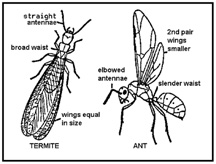 Purdue News
Purdue News
 Purdue News
Purdue News

|
"Don't panic," said Corey Gerber, Purdue University Cooperative Extension entomologist. "They might be flying by and just end up on your house, not intending to start a colony, yet."
Keep an eye on them for a day or two to see if they move on, Gerber said.
While you wait, you can try to figure out who these invaders are. The two types of swarms that cause the most concern are groups of termites and carpenter ants, according to Gerber. They're the ones that are likely to damage the wooden parts of your house.
It's fairly easy to distinguish termites from ants. A swarmer termite has straight antennae, a broad waist and two pairs of wings that are equal in size, Gerber said. An ant has bent antennae and a slender waist. All swarming ants also have two pairs of wings, but the rear pair is much smaller and shorter than the forward pair. All swarmers are either males or queens.
Distinguishing carpenter ants from other types of ants takes an expert eye. At least 8,800 species of ants crawl on our earth, and the many North American species look similar. For positive identification, Gerber said, catch a specimen and take it to the Cooperative Extension office in your county or contact a pest control company.
Identified or not, if the swarm hangs around for more than a few days, or if more than a few hundred coat your siding, Gerber suggests that you call your local pest control company. He also notes that an infestation can start from a single, mated queen who flies unnoticed onto your property to set up housekeeping.
"If you suspect that the insects are building a nest," Gerber said, "spend the money and check it out."
If the invaders are termites or carpenter ants, get several estimates and talk to more than one pest control company before you hire someone, said Judy Logsdon. She is president of the Indiana Pest Control Association, a trade association.
"Absolutely get references on any company you hire, and don't rush into a decision. Termites work slowly. You have time," Logsdon said. "Think of it like bathroom remodeling or putting on a new roof, but do take it seriously. Termites do cause damage, and most of it is not covered by insurance."
For more information on termite control, contact your Cooperative Extension office and ask for publication E-2, "Selecting a Termite Control Service." Or call the Agricultural Communication Service Media Distribution Center at 1-888-EXT-INFO. The cost of the publication is 50 cents.
Source: Corey Gerber, (765) 494-4554
Writer: Rebecca J. Goetz, (765) 494-0461; e-mail rjg@aes.purdue.edu
Purdue News Service: (765) 494-2096; e-mail, purduenews@purdue.edu
NOTE TO JOURNALISTS: A black and white graphic showing the difference between ants and termites is available. Ask for the graphic called Gerber/Swarms.
Photo Caption:
Black-and-white print, electronic transmission, and Web and ftp download available.
Graphic ID: Gerber/Swarms
Download here.